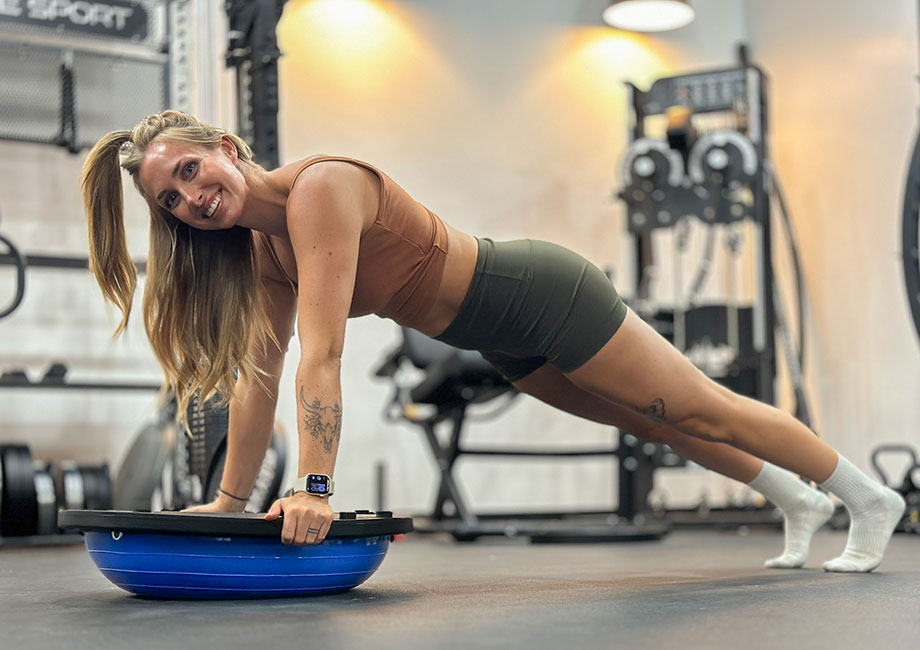We test and review fitness products based on an independent, multi-point methodology. If you use our links to purchase something, we may earn a commission. Read our disclosures.
The BOSU Balance Trainer has gained widespread popularity since its invention in 1999. Commonly referred to as a Bosu ball, this versatile piece of equipment resembles a stability ball cut in half—one side is an inflated dome with a squishy surface, the other a flat platform. The idea is that you can use both sides of the ball to challenge your balance.
We designed this Bosu ball exercise guide to help you elevate your strength training by building muscle and stability like never before! Kate Meier, NASM-CPT, USAW-L1, CF-L1, and GGR senior director of content, helped us put together this list of the 10 best Bosu ball exercises, how to do them, why to do them, and more!
Let’s bounce!
10 Best Bosu Ball Exercises
- Bosu ball bridge
- Bosu ball single-leg glute bridge
- Bosu ball plank
- Bosu ball side plank
- Bosu ball crunches
- Bosu ball push-up
- Bosu ball mountain climber
- Bosu ball squat
- Bosu ball burpee
- Bosu ball side hop
Bosu Ball Bridge
Muscles worked: Glutes, hamstrings, lower back, core
Benefits: According to Physical Therapy in Sport1, performing the glute bridge exercise using unstable surfaces increases EMG muscle activation in the rectus abdominis and external obliques. In layman’s terms, Bosu ball bridges provide one heck of an ab workout!
How to do it:
- Lie supine (facing up) on the floor with your arms extended at your sides, palms pressed into the floor, knees bent, and your feet planted on the dome side of your Bosu ball.
- Engage your core, push through your feet, and thrust your hips upward.
- Continue until your body forms a straight line from shoulders to knees.
- Squeeze your glutes, release, and slowly lower yourself back down.
- Repeat for reps.
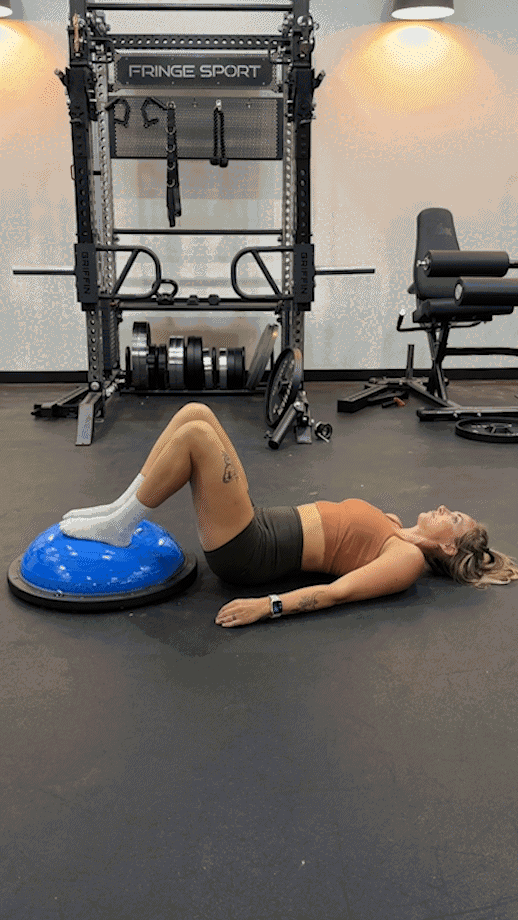
Modifications
- Dial it back: Perform regular bodyweight glute bridges without the Bosu ball.
- Make it harder: Try single-leg Bosu ball glute bridges. Glute bridges or hip thrusts with a dumbbell or weight plate in your lap increases the challenge, too.
Bosu Ball Single-Leg Glute Bridge
Muscles worked: Glutes, hamstrings, lower back, core
Benefits: “Performing your Bosu ball bridges with one leg in the air lets you focus all of your attention on one side at a time while simultaneously posing a greater balance challenge,” says Kate Meier, NASM-CPT, USAW-L1, CF-L1, “so you’re correcting muscle imbalances, building muscle and strength, and developing greater balance and stability by incorporating this advanced movement into your routine.”
How to do it:
- Set up just as you would for the regular Bosu ball bridge.
- Slowly lift your right leg in the air, keeping the left foot firmly planted.
- Brace your core, push through your left foot, and extend your hips.
- Squeeze your glutes at the top, release, and slowly return to the starting position.
- Repeat for reps, then repeat the set with your left leg.
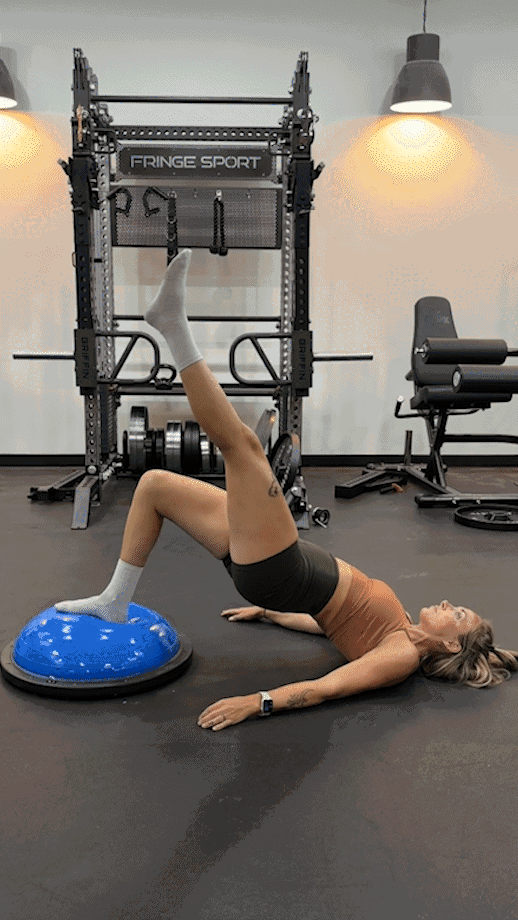
Modifications
- Dial it back: Substitute Bosu ball bridges with both feet planted or even basic glute bridges without the Bosu ball.
- Make it harder: Use a light dumbbell or weight plate to add resistance.
RELATED: Unilateral Exercises
Bosu Ball Plank
Muscles worked: Core, upper body, lower body
Benefits: Planks are hard enough on stable surfaces, but adding a Bosu ball means you’ll work harder to hold steady. According to the Journal of Strength and Conditioning Research2, “planks performed with the instability devices [including Bosu balls] increased EMG activity in the superficial musculature when compared with traditional stable planks.”
How to do it:
- Get on all fours, holding a Bosu ball with the flat side facing your chest.
- Place the dome side of the Bosu ball on the floor, brace your core, step your feet back, and extend your arms so that you are in a high plank position.
- Hold the position for the desired duration, then release.
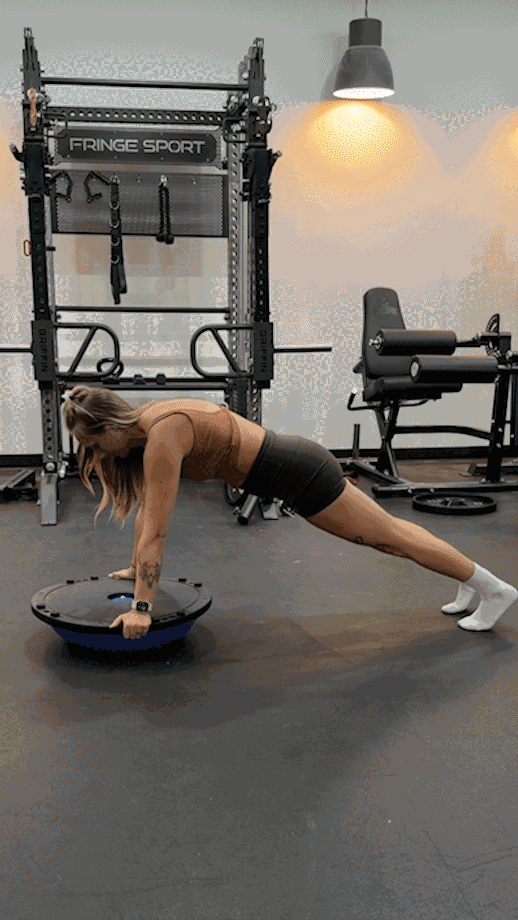
Modifications
- Dial it back: Scale down to the standard high plank or forearm plank exercise.
- Make it harder: Hold the position for longer, do your plank wearing a weighted vest, or try a plank variation.
Bosu Ball Side Plank
Muscles worked: Obliques, glutes, quadratus lumborum, shoulders
Benefits: “Side planks are integral to any well-rounded core workout,” says Kate. “Isolating each side independently lets you get more muscle activation to the obliques, which helps build greater overall core strength and stability.”
How to do it:
- Lie on your left side with your left elbow resting on the dome side of a Bosu ball.
- Push into the Bosu ball to prop up your body, keeping your core braced, legs straight, and hips raised. You may place your right hand on your right hip or extend your right arm toward the ceiling.
- Hold for the desired duration, then release.
- Flip over and repeat the exercise with your right forearm on the ball.
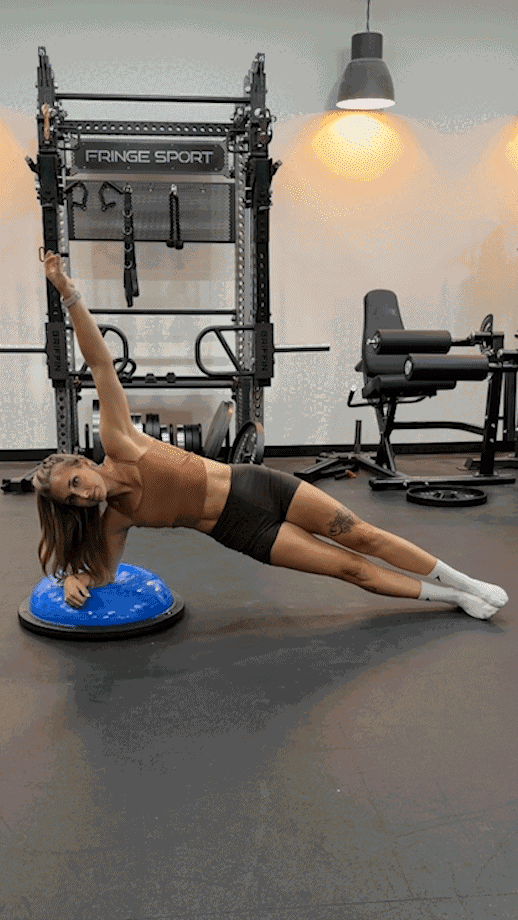
Modifications
- Dial it back: Stick to standard side planks.
- Make it harder: Try side star planks, side plank crunches, or side plank twists.
Bosu Ball Crunches
Muscles worked: Rectus abdominis, transverse abdominis, obliques, multifidus
Benefits: Adding a Bosu ball to a bodyweight movement typically makes it more challenging, but that’s not the case with crunches and sit-ups. A 2014 study3 in the Journal of Strength and Conditioning Research shows that placing a Bosu ball beneath your lower back for crunches and sit-ups actually makes the movements easier, providing a modified version of the classic ab exercise that’s both beginner-friendly and easier on the lower back.
How to do it:
- Lie with your lower back pressed into the dome side of a Bosu ball. Your feet should be firmly planted on the floor and your knees bent at 90-degree angles.
- Take a deep breath, then exhale and lift your head and shoulders off the floor. You may clasp your hands behind your head or cross your arms in front of your chest.
- “Crunch” your abs at the end of the movement, then slowly return to the starting position.
- Repeat for reps.
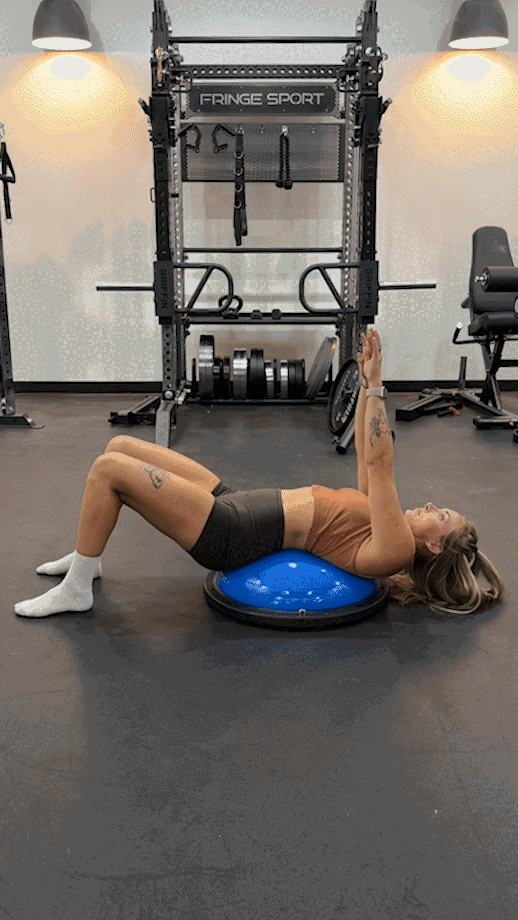
Modifications
- Dial it back: Use a resistance band or TRX suspension trainer anchored in front of you to assist the crunch movement and reduce muscle activation in your core.
- Make it harder: Use a resistance band anchored behind you instead, so you now must fight against resistance on every repetition.
RELATED: How To Do The Crunches Exercise Safely
Bosu Ball Push-Up
Muscles worked: Chest, shoulders, triceps, core
Benefits: The ostensible king of bodyweight exercises benefits from a Bosu ball, too, as performing the push-up movement with that added element of instability recruits stabilizer muscles throughout your entire body.
How to do it:
- Get on all fours, holding a Bosu ball with the flat side facing your chest.
- Place the dome side of the Bosu ball on the floor, step your feet back, and extend your arms so that you are in the push-up position.
- Slowly lower your chest to the ball by bending your elbows.
- Continue until your chest touches the ball.
- Push yourself back up by extending your elbows.
- Repeat for reps.
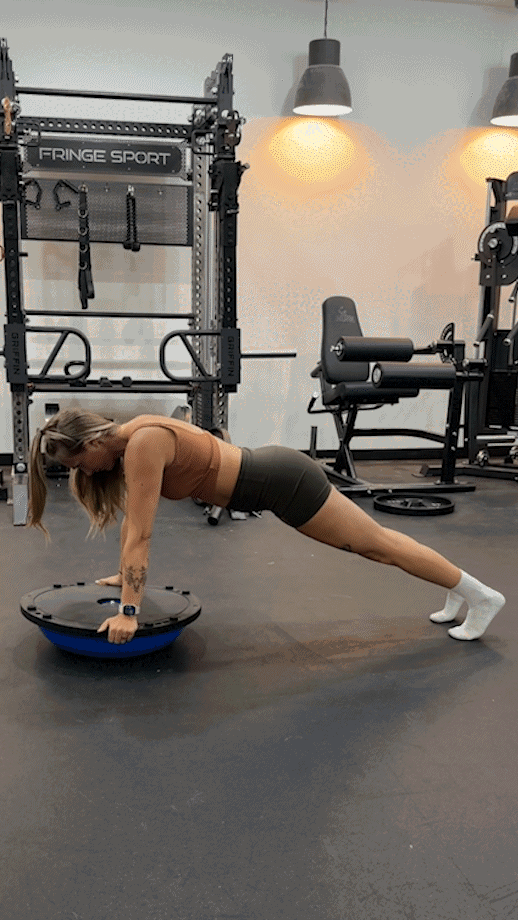
Modifications
- Dial it back: Do regular push-ups.
- Make it harder: Impose a tempo, slap on a weighted vest, or swap out your Bosu ball push-ups for Bosu ball plyometric push-ups.
RELATED: What Muscles Do Push-Ups Work?
Bosu Ball Mountain Climber
Muscles worked: Core, upper body, lower body
Benefits: “Bosu ball mountain climbers are a total-body workout, hitting muscle groups in the upper body, lower body, and the core especially,” explains Kate. “They’re also super high intensity, so they provide an amazing cardio workout.”
How to do it:
- Get on all fours, holding a Bosu ball with the flat side facing your chest.
- Place the dome side of the Bosu ball on the floor, step your feet back, and extend your arms so that you are in the high plank position.
- Drive your left knee toward your left elbow.
- Bring the left foot back as you drive your right knee toward your right elbow.
- Continue in this fashion, alternating legs on each rep, until you finish the set.
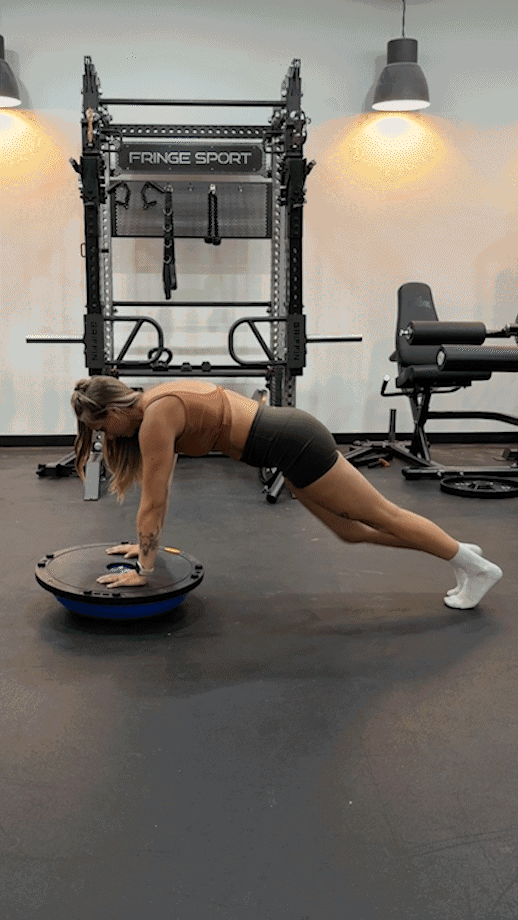
Modifications
- Dial it back: Shelf the Bosu ball and do regular mountain climbers.
- Make it harder: Substitute cross-body mountain climbers (right knee to left elbow, left knee to right elbow) or progress to Bosu ball burpees.
RELATED: Cardio Exercises At Home
Bosu Ball Squat
Muscles worked: Quads, hamstrings, glutes, calves
Benefits: Performing squats atop a Bosu ball “[increases] ankle eversion and knee flexion,” which may improve ankle and knee mobility, “with higher muscle activation in gastrocnemius, biceps femoris, and quadriceps,” which may result in greater muscular hypertrophy in these regions per a 2017 study4 in the Journal of Strength and Conditioning Research.
How to do it:
- Place a Bosu ball on the floor with the flat platform side facing up.
- Step onto the platform and stand with your feet shoulder-width apart, knees slightly bent, back straight, core tight, chest tall, and eyes looking forward.
- Push your hips back and bend your knees to lower yourself into a squat.
- Continue until your thighs are nearly parallel with the floor.
- Pause, then drive through your heels to stand back up.
- Repeat for reps.
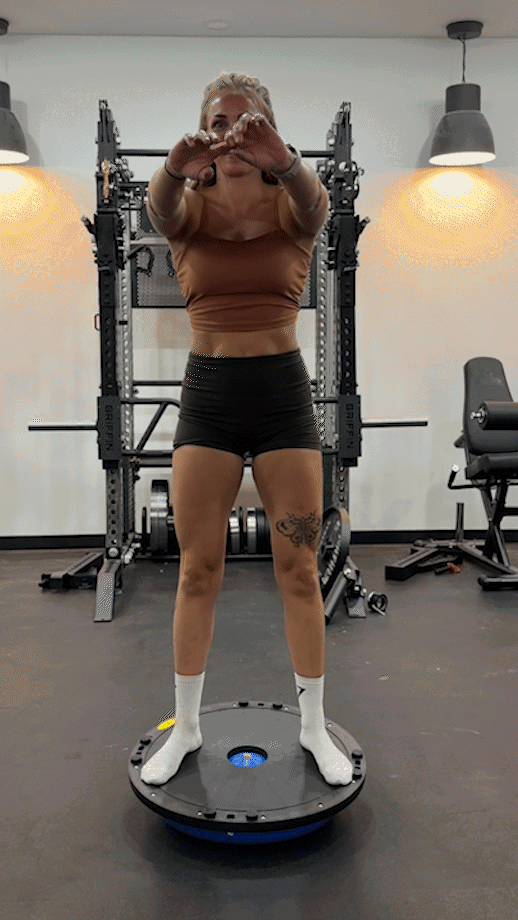
Modifications
- Dial it back: Use a resistance band or TRX suspension trainer anchored in front of you to help you stay stable as you squat or just do regular air squats on the floor.
- Make it harder: Grab one of the best kettlebells and do goblet Bosu ball squats.
Bosu Ball Burpees
Muscles worked: Upper body, lower body, core
Benefits: What better way to build full-body strength than reps of the dreaded burpee? Bosu ball burpees boast the same advantages as the standard version, but the added instability in the bottom position means you’ll work harder to stay steady. You’ll also have to hoist the ball over your head at the end, which increases activation in your upper body.
How to do it:
- Start in a standing position holding a Bosu ball with the flat side facing you.
- Bend down and place the dome side of the Bosu ball on the floor.
- Jump or step both feet back to get into a high plank position.
- Lower your chest to the Bosu ball by bending your elbows.
- Push yourself back into a high plank by extending your elbows.
- Hop or step your feet toward your hands, stand up, and explode into a jump, hoisting your arms and the Bosu ball overhead.
- Land softly, reset, and repeat for reps.
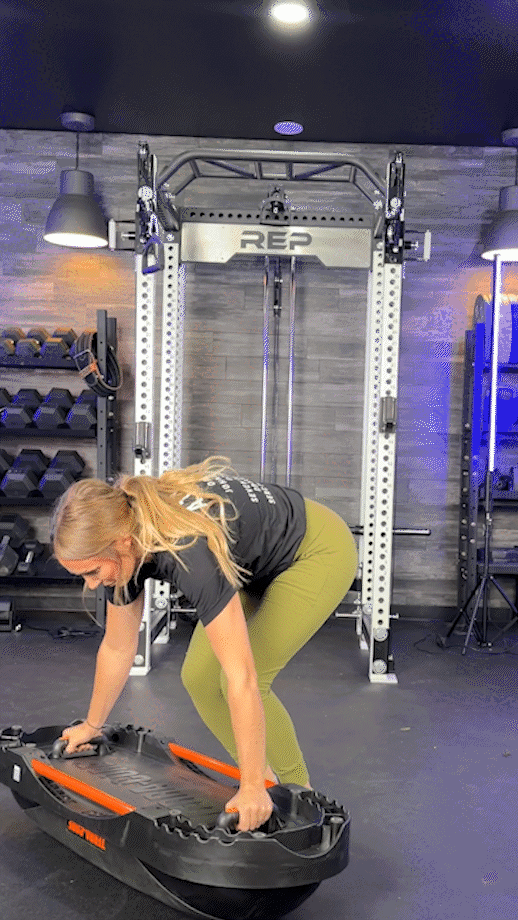
Modifications
- Dial it back: Perform regular burpees without the Bosu ball and/or exclusively step your feet forward and back to keep your heart rate steady.
- Make it harder: Performing a strict push-up on each rep makes the movement more challenging. Jumping your feet forward and back on each rep will spike your heart rate and make it harder, too. But, if you really want to land yourself in the pain cave, trade your Bosu ball burpees for the devil press.
Bosu Ball Side Hop
Muscles worked: Quads, glutes, hamstrings, hip flexors
Benefits: “The Bosu ball side hop is great for building lower-body strength and muscle while also improving your balance and coordination,” says Kate. “It’s great as a warm-up exercise, a cardio workout, or for all-purpose strength training.”
How to do it:
- Place a Bosu ball on the floor, dome side up, and stand with it on your left side.
- Jump laterally to the left and land with both feet on the ball.
- Stabilize yourself, then jump to the left again, landing with both feet on the floor.
- Repeat the above steps, this time jumping to the right, until you’re back where you started with the Bosu ball on your left.
- Repeat as needed.
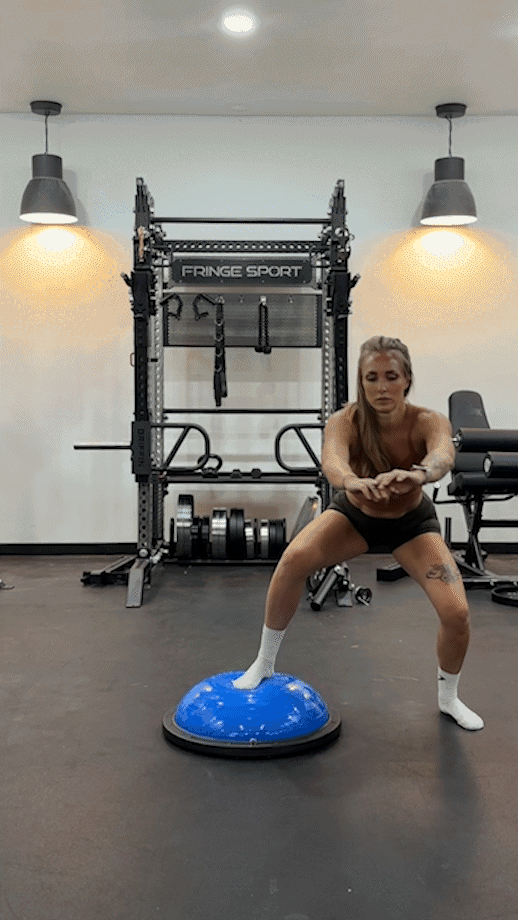
Modifications
- Dial it back: Step on and off the ball with one foot at a time rather than jumping.
- Make it harder: Tuck your knees into your chest on each jump.
RELATED: The 7 Best Plyometric Exercises
Sample Bosu Ball Workouts
Bosu ball exercises can be generally beneficial to your overall health and wellness, but a little bit of programming provided by a personal trainer can help you really make some headway on your goals. Thankfully, we here at GGR have personal trainers in spades!
Check out these sample Bosu ball workouts from Kate Meier, NASM-CPT, USAW-L1, CF-L1.
Bosu Ball Full-Body Workout
We love workout splits, but plenty of people prefer the convenience of a comprehensive full-body approach to strength training. So, we’ve put together a circuit training workout that’ll tick all your boxes—or muscle groups, technically speaking—to help you build strength and muscle from head to toe.
“Running through this circuit can also serve as a warm-up if you’re getting into training splits or weightlifting in the same session,” says Kate. “Just keep the intensity low to moderate if you’re using this set for that purpose. If it’s your whole workout, on the other hand, keep the intensity high, minimize rest, and aim to do two or three sets for time.”
| Exercise | Sets | Reps |
| Bosu Ball Mountain Climber | 1-3 | 10-20 |
| Bosu Ball Squat | 1-3 | 8-12 |
| Bosu Ball Push-Up | 1-3 | 8-12 |
| Bosu Ball Side Hop | 1-3 | 10-20 |
| Bosu Ball Burpees | 1-3 | 6-12 |
Bosu Ball Workout for Core Strength and Stability
You can also add a little oomph to your functional core exercises by incorporating Bosu ball exercises. The added element of instability forces your muscles to work harder so you don’t teeter, totter, and topple over.
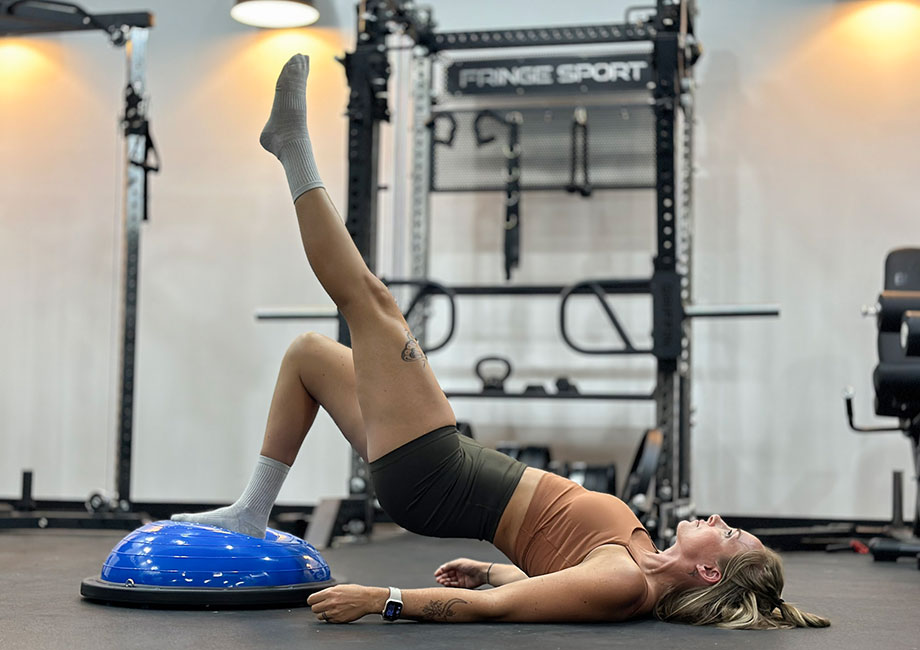
“It’s important to take your time with these exercises if you’re looking to build core strength and stability,” says Kate. “When you rush you rely on momentum and reduce your time under tension, resulting in less actual work completed. Move slowly and deliberately, keeping your core braced throughout the full range of motion of every rep.”
| Exercise | Sets | Reps |
| Bosu Ball Crunches | 3-5 | 10-20 |
| Bosu Ball Bridge | 3-5 | 10-20 |
| Bosu Ball Plank | 3-5 | 30-60 sec. |
| Bosu Ball Single-Leg Glute Bridge | 3-5 | 10-20 |
| Bosu Ball Side Plank | 3-5, each side | 30-60 sec. |
Bosu Ball Workout for Balance
Using a Bosu ball during your workout effectively strengthens your stabilizers, helps develop your coordination, and enhances your balance. Take your time with each rep, maximizing your time under tension and tasking yourself with keeping rock-steady throughout the full range of motion.
| Exercise | Sets | Reps |
| Bosu Ball Mountain Climber | 3-5 | 10-20 |
| Bosu Ball Squat | 3-5 | 8-12 |
| Bosu Ball Side Hop | 3-5 | 10-20 |
| Bosu Ball Burpees | 3-5 | 8-12 |
| Bosu Ball Plank | 3-5 | 30-60 sec. |
RELATED: Balance Exercises
Benefits of Bosu Ball Training
The beautiful thing about the Bosu ball is that this versatile piece of equipment packs a ton of functionality, offering various benefits to those who incorporate Bosu ball exercises into their workouts. Here are a few of our favorite ones.
Offers a Full-Body Workout
The Bosu ball offers an excellent selection of exercises that allow you to get muscle activation virtually everywhere. That makes them the ideal training tool for full-body workouts, circuit training, all-purpose strength training, and cardio conditioning.
Pieces of equipment that serve multiple functions are great in the gym, but they’re even better at home, especially if your home or garage gym doesn’t have the floor space to shell out for the big bulky stuff like rigs, racks, or cardio machines.
RELATED: Full-Body Workout Vs Split
May Help Improve Balance
Using Bosu ball exercises in your strength training program may help improve your balance and stability. According to the Journal of Athletic Training5, study subjects showed “improved dynamic postural control and ankle force production” following a four-week training plan incorporating Bosu ball exercises.
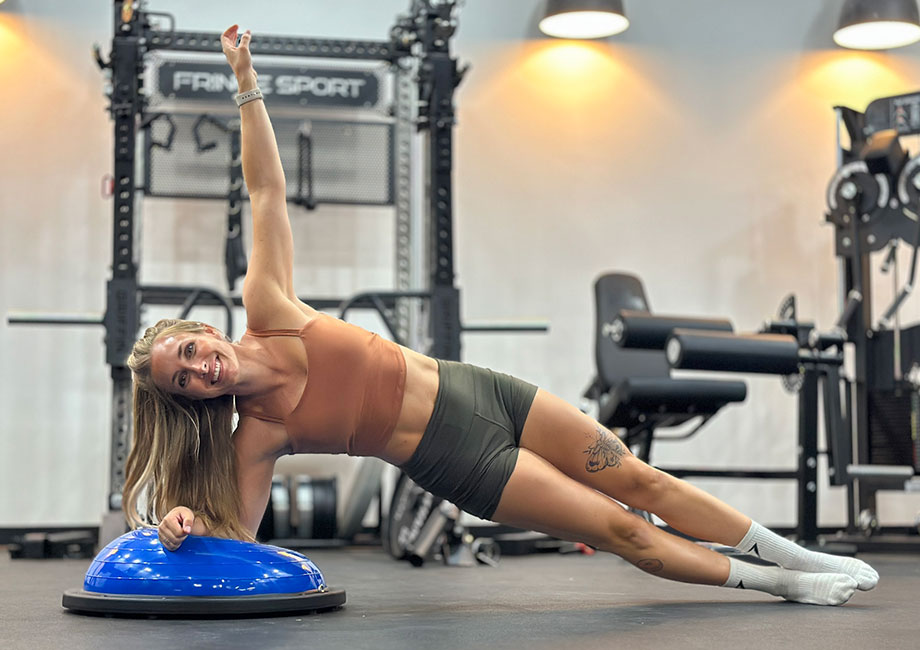
“That’s because performing exercises with a Bosu ball, irrespective of the exercise, involves an element of instability that causes your muscles to prioritize stability over force production,” says Kate. “You have to engage your core to a greater degree and make minute adjustments to stay steady, which helps improve balance and stability.”
May Reduce Risk of Injury
In a 2015 Sports Health6 study, subjects who landed on a Bosu ball when performing the single-leg drop exercise showed greater peak hamstring activation, which led researchers to conclude that using “unstable surfaces as a training tool [may] reduce the risk of ACL injury.”
Bosu ball exercises provide a low-impact modality to minimize the stress on your joints. That’s great in general but may be hugely important for those at high risk for injury, including high-performance athletes, older adults, and individuals who have experienced past injuries and are at risk for reinjury.
Bosu Ball Exercises: Final Thoughts
If your workout routine is feeling stale, Bosu ball exercises are the perfect way to shake things up—literally! Bosu ball exercises:
- Offer incredible exercise variety
- May provide a full-body workout
- Can be used for both cardio and strength
- May improve balance and stability
- Provide increased core activation
- Are low-impact and joint-friendly
There’s a lot to love about Bosu ball exercises, which is why they’re becoming increasingly popular today. So, what are you waiting for? Work some of our Bosu ball exercises into your workout routine, and get your wobble on today!
Bosu Ball Exercises: FAQs
Are bosu ball workouts effective?
Workouts incorporating Bosu ball exercises are generally effective but can be especially effective for improving balance and stability. That’s because Bosu balls force you to adapt to exercising on an unstable
What are the disadvantages of the bosu ball?
Exercising on an unstable surface works wonders for your balance and stability, but it’s harder to accomplish other training goals under such circumstances.
According to the International Journal of Environmental Research and Public Health7, “instability, in comparison to a stable condition, decreases the parameters of strength, power, and muscular speed in adults.”
So, if your goal is to prioritize strength gain or power production, Bosu ball exercises may be less effective than other traditional strength training methods.
What muscles does the bosu ball work?
You name it, the Bosu ball works it. Because you can perform upper-body, lower-body, and core exercises using a Bosu Ball, you have the potential to get a full-body workout with this tool.
Are bosu balls good for seniors?
Absolutely!
The Journal of Sports Science and Medicine8 observed that a 12-week proprioception program involving Bosu ball exercises “significantly [improved] flexibility, balance, and lumbar strength in older adults.”
Likewise, BMC Geriatrics9 found that an exercise program involving unstable surfaces and Bosu ball exercises positively affected “lower-extremity muscle strength, power and balance in older adults,” leading researchers to conclude that Bosu ball exercises are “effective and safe [for mitigating] intrinsic fall risk factors in older adults.”
That’s all fine and good, but before you buy your grandparents a Bosu ball for Christmas, make sure they speak to their doctor or other qualified medical professional.
References
- Czaprowski D, Afeltowicz A, Gębicka A, et al. Abdominal muscle EMG-activity during bridge exercises on stable and unstable surfaces. Phys Ther Sport. 2014;15(3):162-168. doi:10.1016/j.ptsp.2013.09.003
- Snarr RL, Esco MR. Electromyographical comparison of plank variations performed with and without instability devices. J Strength Cond Res. 2014;28(11):3298-3305. doi:10.1519/JSC.0000000000000521
- Saeterbakken AH, Andersen V, Jansson J, Kvellestad AC, Fimland MS. Effects of BOSU ball(s) during sit-ups with body weight and added resistance on core muscle activation. J Strength Cond Res. 2014;28(12):3515-3522. doi:10.1519/JSC.0000000000000565
- Nairn BC, Sutherland CA, Drake JD. Motion and Muscle Activity Are Affected by Instability Location During a Squat Exercise. J Strength Cond Res. 2017;31(3):677-685. doi:10.1519/JSC.0000000000001745
- Cuğ M, Duncan A, Wikstrom E. Comparative Effects of Different Balance-Training-Progression Styles on Postural Control and Ankle Force Production: A Randomized Controlled Trial. J Athl Train. 2016;51(2):101-110. doi:10.4085/1062-6050-51.2.08
- Shultz R, Silder A, Malone M, Braun HJ, Dragoo JL. Unstable Surface Improves Quadriceps:Hamstring Co-contraction for Anterior Cruciate Ligament Injury Prevention Strategies. Sports Health. 2015;7(2):166-171. doi:10.1177/1941738114565088
- Marquina M, Lorenzo-Calvo J, Rivilla-García J, García-Aliaga A, Refoyo Román I. Effects on Strength, Power and Speed Execution Using Exercise Balls, Semi-Sphere Balance Balls and Suspension Training Devices: A Systematic Review. Int J Environ Res Public Health. 2021;18(3):1026. Published 2021 Jan 24. doi:10.3390/ijerph18031026
- Emilio EJ, Hita-Contreras F, Jiménez-Lara PM, Latorre-Román P, Martínez-Amat A. The association of flexibility, balance, and lumbar strength with balance ability: risk of falls in older adults. J Sports Sci Med. 2014;13(2):349-357. Published 2014 May 1.
- Eckardt N. Lower-extremity resistance training on unstable surfaces improves proxies of muscle strength, power and balance in healthy older adults: a randomised control trial. BMC Geriatr. 2016;16(1):191. Published 2016 Nov 24. doi:10.1186/s12877-016-0366-3
Further reading

Can you lose weight on an exercise bike? We break down the answer—and bust some myths—here. Read more

It’s a battle of the brands in this Rogue dumbbells vs REP dumbbells comparison. Which will land on top? Read more

The BOSU Balance Trainer has gained widespread popularity since its invention in 1999. Commonly referred to as a Bosu ball, this versatile piece of equipment resembles a stability ball cut in half—one side is an inflated dome with a squishy surface, the other a flat platform. The idea is that you can use both sides of the ball to challenge your balance.We designed this Bosu ball exercise guide to help you elevate your strength training by building muscle and stability like never before! » Read more about: Balance Out Your Training Routine With These Top Bosu Ball Exercises! » Read more

The best massage guns are powerful, quiet, and portable. Here are our top picks for percussive massage devices in 2025. Read more

